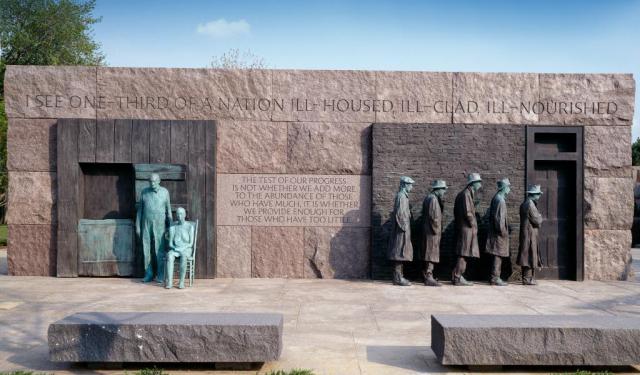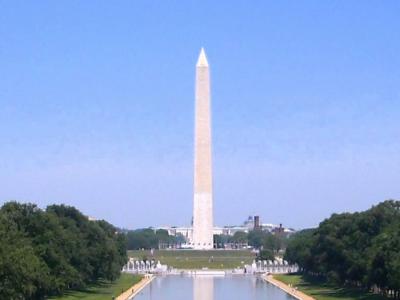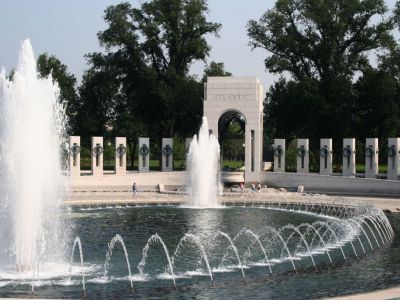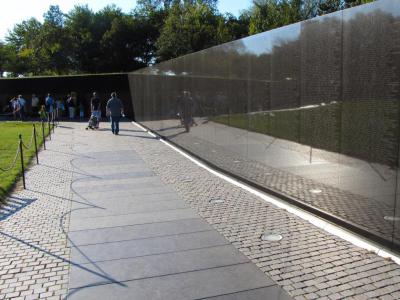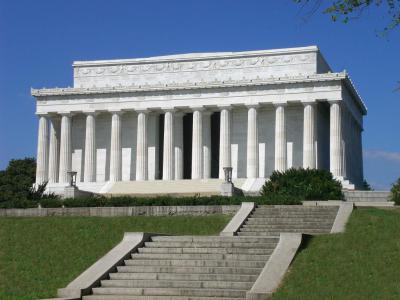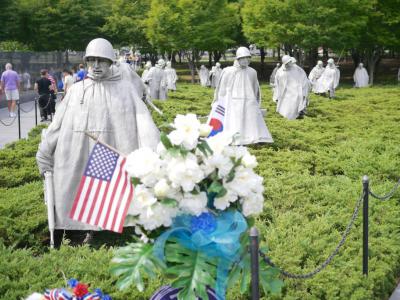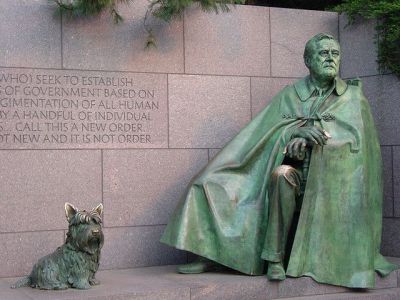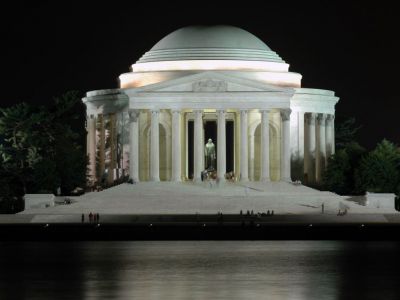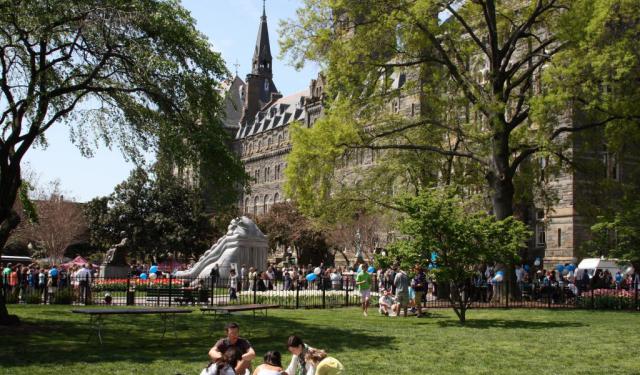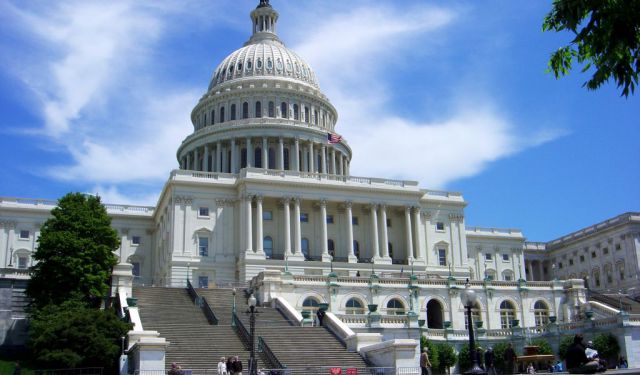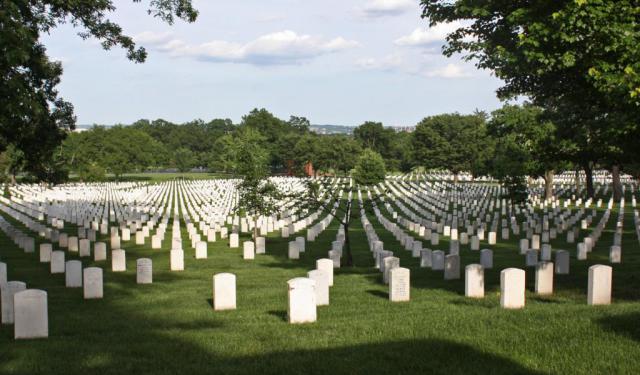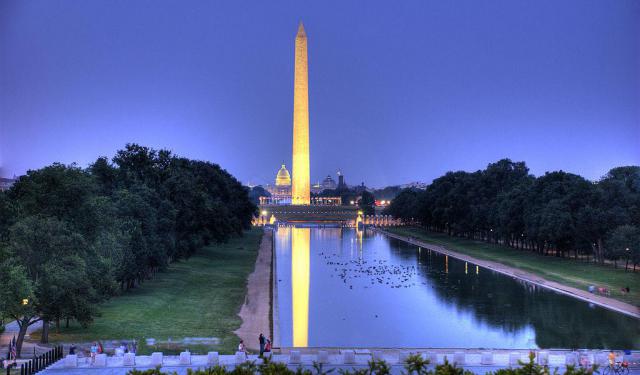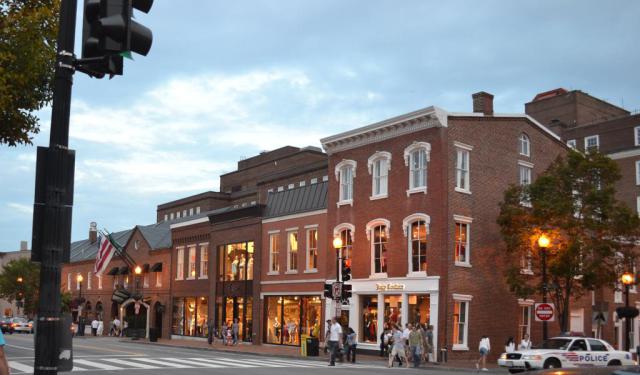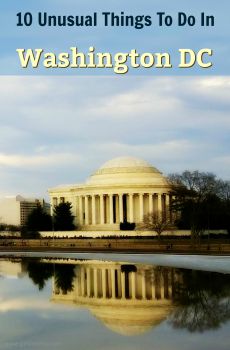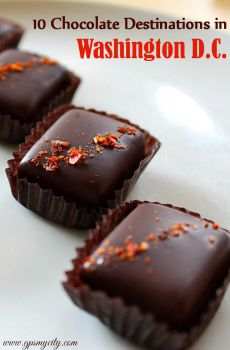DC Monuments and Memorials Walking Tour (Self Guided), Washington D.C.
"In the end, it's not the years in your life that count. It's the life in your years," goes the famous quote by Abraham Lincoln.
Indeed, those remembered in Washington, D.C. – the renowned statesmen, politicians, fallen soldiers, and other distinguished persons – had their years filled with life to the brim. What they left behind is a great legacy manifested in historic events and memorable ideas that today are worthy of paying tribute to with monuments and memorials. These landmarks serve as important symbols of American values – a powerful reminder of the nation's past and the individuals who played significant roles in shaping the United States.
Towering at the western end of the National Mall is the Washington Monument, one of the most iconic landmarks of the U.S. capital, honoring George Washington, the first President of the United States. The Lincoln Memorial, at the opposite end of the Mall, features a majestic statue of the 16th U.S. President seated in contemplation, surrounded by inscriptions of his famous speeches, including the Gettysburg Address.
Set along Tidal Basin you will find the neoclassical Jefferson Memorial, honoring the country's third President and the principal author of the Declaration of Independence. Nearby is the one paying homage to Franklin Delano Roosevelt.
The names etched in stone here reflect the ideals of freedom, sacrifice, and the enduring spirit of the United States. If you wish to capture the essence of the Washington, D.C. memorials and the values they represent, our self-guided walking tour will offer you a chance to do that.
Indeed, those remembered in Washington, D.C. – the renowned statesmen, politicians, fallen soldiers, and other distinguished persons – had their years filled with life to the brim. What they left behind is a great legacy manifested in historic events and memorable ideas that today are worthy of paying tribute to with monuments and memorials. These landmarks serve as important symbols of American values – a powerful reminder of the nation's past and the individuals who played significant roles in shaping the United States.
Towering at the western end of the National Mall is the Washington Monument, one of the most iconic landmarks of the U.S. capital, honoring George Washington, the first President of the United States. The Lincoln Memorial, at the opposite end of the Mall, features a majestic statue of the 16th U.S. President seated in contemplation, surrounded by inscriptions of his famous speeches, including the Gettysburg Address.
Set along Tidal Basin you will find the neoclassical Jefferson Memorial, honoring the country's third President and the principal author of the Declaration of Independence. Nearby is the one paying homage to Franklin Delano Roosevelt.
The names etched in stone here reflect the ideals of freedom, sacrifice, and the enduring spirit of the United States. If you wish to capture the essence of the Washington, D.C. memorials and the values they represent, our self-guided walking tour will offer you a chance to do that.
How it works: Download the app "GPSmyCity: Walks in 1K+ Cities" from Apple App Store or Google Play Store to your mobile phone or tablet. The app turns your mobile device into a personal tour guide and its built-in GPS navigation functions guide you from one tour stop to next. The app works offline, so no data plan is needed when traveling abroad.
DC Monuments and Memorials Walking Tour Map
Guide Name: DC Monuments and Memorials Walking Tour
Guide Location: USA » Washington D.C. (See other walking tours in Washington D.C.)
Guide Type: Self-guided Walking Tour (Sightseeing)
# of Attractions: 8
Tour Duration: 2 Hour(s)
Travel Distance: 3.6 Km or 2.2 Miles
Author: irene
Sight(s) Featured in This Guide:
Guide Location: USA » Washington D.C. (See other walking tours in Washington D.C.)
Guide Type: Self-guided Walking Tour (Sightseeing)
# of Attractions: 8
Tour Duration: 2 Hour(s)
Travel Distance: 3.6 Km or 2.2 Miles
Author: irene
Sight(s) Featured in This Guide:
- Washington Monument
- World War II Memorial
- Vietnam Veterans Memorial
- Lincoln Memorial
- Korean War Veterans Memorial
- Martin Luther King, Jr. Memorial
- Franklin Delano Roosevelt Memorial
- Thomas Jefferson Memorial
1) Washington Monument (must see)
The Washington Monument was built to honor George Washington. It stands in the center of the US Capital to symbolize the importance of President Washington to the country. The idea to build the monument was first discussed in 1783. It wasn’t until 1847 that a design was agreed upon. However, that design was very different from the monument that stands today.
The obelisk was to rise above a temple that would house artifacts of American presidents and heroes. Over the years that plan was dropped, and today the obelisk is rather plain. The first cornerstone was laid in a Masonic ceremony on July 4, 1848. The same Masonic trowel that President Washington used to lay the cornerstone for the Capitol was used.
Work on the Washington Monument was slow and eventually stopped altogether during the Civil War. Modifications were made to the design and the work resumed in 1880, with the capstone placed on December 6, 1884. The hollow shaft of the monument contains an elevator to the top plus a staircase with 897 steps. There are 188 interesting, carved blocks of stone to be viewed along the staircase, quarried of native stones brought from all the 50 states. These stones were originally supposed to arrive with a donation attached to raise funds. Eventually, the stones arrived but the donation did not.
Go to the top of the monument to get the amazing views of Washington DC. It will be a highlight of your trip.
Tip:
Entry is free, but a ticket is a must for everyone going into the monument.
One person from your party can obtain up to 6 tickets and pick a time to go up in the monument. Tickets can also be ordered ahead of time for a fee.
The obelisk was to rise above a temple that would house artifacts of American presidents and heroes. Over the years that plan was dropped, and today the obelisk is rather plain. The first cornerstone was laid in a Masonic ceremony on July 4, 1848. The same Masonic trowel that President Washington used to lay the cornerstone for the Capitol was used.
Work on the Washington Monument was slow and eventually stopped altogether during the Civil War. Modifications were made to the design and the work resumed in 1880, with the capstone placed on December 6, 1884. The hollow shaft of the monument contains an elevator to the top plus a staircase with 897 steps. There are 188 interesting, carved blocks of stone to be viewed along the staircase, quarried of native stones brought from all the 50 states. These stones were originally supposed to arrive with a donation attached to raise funds. Eventually, the stones arrived but the donation did not.
Go to the top of the monument to get the amazing views of Washington DC. It will be a highlight of your trip.
Tip:
Entry is free, but a ticket is a must for everyone going into the monument.
One person from your party can obtain up to 6 tickets and pick a time to go up in the monument. Tickets can also be ordered ahead of time for a fee.
2) World War II Memorial (must see)
The World War II Memorial has a grand design that reflects the vastness of a war that spanned the entire globe. Two arches at either end of the memorial are symbolic of the Pacific and Atlantic areas of fighting. 56 pillars are arranged in two semicircles around both arches that represent the 48 states at the time of the war and the District of Columbia, plus the territories of Alaska, Hawaii, Puerto Rico, Guam, U.S. Virgin Islands, American Samoa, and the Philippines.
The walls between the arches and in front of the pillars depict scenes that were typical of the Pacific and European theaters of the war. These are depicted in bas relief. An engraving of the ubiquitous “Kilroy Was Here” is also present. "Kilroy Was Here" is a meme that became popular during World War II, typically seen in graffiti. Its origin is debated, but the phrase and the distinctive accompanying doodle became associated with GIs in the 1940s.
On the west side sits the Freedom Wall that contains 4,048 gold stars each one representing 100 American soldiers who died or remain missing during WWII. Behind the Freedom Wall is the Reflecting Pool on the Mall. In front of the wall is the World War II Memorial Rainbow Pool and the stars reflect in the water. It makes for a very moving scene.
Almost 2/3 of the site is water or landscaping so the components of the memorial really stand out. The site is available for visiting 24 hours a day except around Memorial Day activities. Rangers are on hand to answer questions from around 10am to 11pm.
Why You Should Visit:
One of the more formal-style memorials, it carries a certain gravity, conveys a somber nature, and provides lots of space to reflect on the drama of WWII.
The small bronze relief panels on the walls show scenes of different wartime activities that give you a bit more insight into the lives of people during the war.
The entire site sits on a little over seven acres, so wear comfortable walking shoes.
Tip:
Entry is free but do it on a clear day if you can. On a wet day, there is nowhere much to shelter. If you join a guided tour, it's recommended to get some explanation of all the symbolism and pageantry.
The walls between the arches and in front of the pillars depict scenes that were typical of the Pacific and European theaters of the war. These are depicted in bas relief. An engraving of the ubiquitous “Kilroy Was Here” is also present. "Kilroy Was Here" is a meme that became popular during World War II, typically seen in graffiti. Its origin is debated, but the phrase and the distinctive accompanying doodle became associated with GIs in the 1940s.
On the west side sits the Freedom Wall that contains 4,048 gold stars each one representing 100 American soldiers who died or remain missing during WWII. Behind the Freedom Wall is the Reflecting Pool on the Mall. In front of the wall is the World War II Memorial Rainbow Pool and the stars reflect in the water. It makes for a very moving scene.
Almost 2/3 of the site is water or landscaping so the components of the memorial really stand out. The site is available for visiting 24 hours a day except around Memorial Day activities. Rangers are on hand to answer questions from around 10am to 11pm.
Why You Should Visit:
One of the more formal-style memorials, it carries a certain gravity, conveys a somber nature, and provides lots of space to reflect on the drama of WWII.
The small bronze relief panels on the walls show scenes of different wartime activities that give you a bit more insight into the lives of people during the war.
The entire site sits on a little over seven acres, so wear comfortable walking shoes.
Tip:
Entry is free but do it on a clear day if you can. On a wet day, there is nowhere much to shelter. If you join a guided tour, it's recommended to get some explanation of all the symbolism and pageantry.
3) Vietnam Veterans Memorial
When most people think of the Vietnam Veterans Memorial (VVM), they typically envision the Vietnam Veterans Memorial Wall. There are two other components to the memorial, however: The Vietnam Women’s Memorial and the Three Soldiers statue. All three components are located in Constitution Gardens of the National Mall.
The U.S. involvement in Vietnam began in 1959. The last US serviceman died in Vietnam on May 15, 1975. Throughout this time the country had varying degrees of support for the war. One of the precepts of the Vietnam Veterans Memorial was to not let any of the controversy mar the honoring of the service men and women who served during that time. Even though the memorial itself has had some controversy, time is healing the wounds. The somber reflecting wall with all the names etched into stone lets visitors to the Vietnam Veterans Memorial focus on the sacrifice that has been made. There are currently 58,267 names listed on the wall of service personnel that was either killed or missing in action. There are no civilian names listed on The Wall.
The Vietnam Women’s Memorial is situated just south of The Wall. It shows three uniformed women helping a wounded soldier. The women’s names are Faith, Hope, and Charity. A total of 67 women died during the Vietnam War – 8 were servicewomen, and 59 were civilians in a support role.
The Three Soldiers portion of the Vietnam Veterans Memorial was created amid the controversy that surrounded The Wall. Some members of Congress wanted a more traditional memorial. The bronze statues of the service members depict soldiers wearing the common gear of the Vietnam War. They are positioned so they are looking at the names on The Wall.
The Vietnam Veterans Memorial is open 24 hours a day with rangers available to answer questions from 9:30am to 11:30pm. There are directories at the entrance to The Wall to help you find a specific name. There are also several websites that list the names on The Wall.
Why You Should Visit:
The gravity of the Vietnam War is not truly understood until you see all the names etched for eternity on the memorial's wall.
Tip:
Do it on a clear day if you can. On a wet day, there is nowhere much to shelter.
If you want unobstructed photographs or more peaceful, quiet visits, it is best to visit very early in the morning, just after daybreak.
The U.S. involvement in Vietnam began in 1959. The last US serviceman died in Vietnam on May 15, 1975. Throughout this time the country had varying degrees of support for the war. One of the precepts of the Vietnam Veterans Memorial was to not let any of the controversy mar the honoring of the service men and women who served during that time. Even though the memorial itself has had some controversy, time is healing the wounds. The somber reflecting wall with all the names etched into stone lets visitors to the Vietnam Veterans Memorial focus on the sacrifice that has been made. There are currently 58,267 names listed on the wall of service personnel that was either killed or missing in action. There are no civilian names listed on The Wall.
The Vietnam Women’s Memorial is situated just south of The Wall. It shows three uniformed women helping a wounded soldier. The women’s names are Faith, Hope, and Charity. A total of 67 women died during the Vietnam War – 8 were servicewomen, and 59 were civilians in a support role.
The Three Soldiers portion of the Vietnam Veterans Memorial was created amid the controversy that surrounded The Wall. Some members of Congress wanted a more traditional memorial. The bronze statues of the service members depict soldiers wearing the common gear of the Vietnam War. They are positioned so they are looking at the names on The Wall.
The Vietnam Veterans Memorial is open 24 hours a day with rangers available to answer questions from 9:30am to 11:30pm. There are directories at the entrance to The Wall to help you find a specific name. There are also several websites that list the names on The Wall.
Why You Should Visit:
The gravity of the Vietnam War is not truly understood until you see all the names etched for eternity on the memorial's wall.
Tip:
Do it on a clear day if you can. On a wet day, there is nowhere much to shelter.
If you want unobstructed photographs or more peaceful, quiet visits, it is best to visit very early in the morning, just after daybreak.
4) Lincoln Memorial (must see)
The Lincoln Memorial is one of the most famous monuments and historical places in the United States. It is a nationally recognized location that was built in honor of Abraham Lincoln, who was the 16th President of the United States during the bloody years of the Civil War. The monument is a fine example of a classic Greek Doric temple. Even the sculpture of the President is done in Olympic Godlike fashion. Two well-known speeches of the former President are also engraved there: the Gettysburg Address and Lincoln’s Second Inaugural Address.
The Lincoln Monument Association was formed two years after the death of the President. Planning for the memorial, though, stretched out until 1901. The Lincoln Memorial Bill was signed by President Taft in 1911. Interestingly, the entire monument was built for just $2 million. Today, the site is famous as the location for many historic speeches, like the “I have a dream” speech by the Rev. Martin Luther King. It has also been the site for many famous protests. The Monument is cared for by the National Park Service and is listed on the National Register of Historic Places. The monument is open 24 hours a day.
Why You Should Visit:
The most visited memorial in the National Mall for a reason; it is beautiful and offers a fantastic view of the reflecting pool and the Washington Monument.
Tip:
Go first thing in the morning (probably before 9am) or later in the evening (when the lights are on) to avoid the crowds.
Right on the steps, look down on the floor for the "I have a dream" block. It's where MLK, Jr. stood when he gave his most famous speech.
Pack your food and water (in the summer) because the food at the refreshment stands is not very good and somewhat overpriced.
The Lincoln Monument Association was formed two years after the death of the President. Planning for the memorial, though, stretched out until 1901. The Lincoln Memorial Bill was signed by President Taft in 1911. Interestingly, the entire monument was built for just $2 million. Today, the site is famous as the location for many historic speeches, like the “I have a dream” speech by the Rev. Martin Luther King. It has also been the site for many famous protests. The Monument is cared for by the National Park Service and is listed on the National Register of Historic Places. The monument is open 24 hours a day.
Why You Should Visit:
The most visited memorial in the National Mall for a reason; it is beautiful and offers a fantastic view of the reflecting pool and the Washington Monument.
Tip:
Go first thing in the morning (probably before 9am) or later in the evening (when the lights are on) to avoid the crowds.
Right on the steps, look down on the floor for the "I have a dream" block. It's where MLK, Jr. stood when he gave his most famous speech.
Pack your food and water (in the summer) because the food at the refreshment stands is not very good and somewhat overpriced.
5) Korean War Veterans Memorial (must see)
The Korean War Veterans Memorial stands in West Potomac Park within Washington, D.C. Its purpose is to pay tribute to all those who served during the Korean conflict. The United States provided assistance to South Korea when it was invaded by North Korea at the behest of the United Nations. The U.S. had divided opinions about the conflict, often referring to it as a "conflict" rather than a full-fledged war. The Korean War was a grueling battle that took place in extremely harsh conditions, with temperatures dropping to as low as -40°F during the Chosin Reservoir battle.
The memorial is designed in the shape of a triangle and is constructed using juniper and strips of concrete to mimic the rugged terrain of the battlefield. This triangular shape symbolizes the Field of Service. Within this landscape, you'll find 19 statues of soldiers dressed in military attire, their clothing appearing to be windblown, evoking memories of the brutal weather conditions endured. These soldier statues are crafted from stainless steel. On the south side of the memorial, there's a black granite wall that reflects the statues in such a way that it creates the illusion of a total of 38 soldiers, paying homage to the 38th parallel, which separates North Korea from South Korea.
At the end of the Field of Service, there's a triangular reflecting pool. Along the northern side, there's a low granite wall bearing the names of the 22 United Nations member countries that participated in the Korean War. The memorial is open for visitors around the clock, and park rangers are on hand from 8 a.m. to 12 a.m. daily, except for major holidays.
Why You Should Visit:
The company of soldiers depicted as moving through hostile terrain is a bit eerie and very lifelike, making this one of the most remarkable war memorials you'll ever see.
Tip:
Truly better to visit after dark; the lighting is so very dramatic, you can almost hear the soldiers' boots sloshing through the mud.
Additionally, use your phone flashlight to look carefully at the black wall that has images of soldiers laser-etched onto the black surface.
The memorial is designed in the shape of a triangle and is constructed using juniper and strips of concrete to mimic the rugged terrain of the battlefield. This triangular shape symbolizes the Field of Service. Within this landscape, you'll find 19 statues of soldiers dressed in military attire, their clothing appearing to be windblown, evoking memories of the brutal weather conditions endured. These soldier statues are crafted from stainless steel. On the south side of the memorial, there's a black granite wall that reflects the statues in such a way that it creates the illusion of a total of 38 soldiers, paying homage to the 38th parallel, which separates North Korea from South Korea.
At the end of the Field of Service, there's a triangular reflecting pool. Along the northern side, there's a low granite wall bearing the names of the 22 United Nations member countries that participated in the Korean War. The memorial is open for visitors around the clock, and park rangers are on hand from 8 a.m. to 12 a.m. daily, except for major holidays.
Why You Should Visit:
The company of soldiers depicted as moving through hostile terrain is a bit eerie and very lifelike, making this one of the most remarkable war memorials you'll ever see.
Tip:
Truly better to visit after dark; the lighting is so very dramatic, you can almost hear the soldiers' boots sloshing through the mud.
Additionally, use your phone flashlight to look carefully at the black wall that has images of soldiers laser-etched onto the black surface.
6) Martin Luther King, Jr. Memorial (must see)
The Martin Luther King, Jr. Memorial can be found in West Potomac Park, Washington DC, situated to the southwest of the National Mall. This imposing monument occupies the northwest corner of the Tidal Basin, close to the Franklin Delano Roosevelt Memorial. It's strategically aligned in a way that connects the Lincoln Memorial to the northwest and the Jefferson Memorial to the southeast. The monument's official address, 1964 Independence Avenue, S.W., commemorates the year the Civil Rights Act of 1964 was passed, a pivotal moment in the Civil Rights movement with Dr. King's significant involvement.
Spanning four acres, the memorial was opened to the public on August 22, 2011, following over two decades of planning, fundraising, and construction. Originally, a dedication ceremony was planned for Sunday, August 28, 2011, which marked the 48th anniversary of Dr. Martin Luther King, Jr.'s "I Have a Dream" speech delivered from the steps of the Lincoln Memorial in 1963. However, this event was postponed to October 16, the 16th anniversary of the 1995 Million Man March on the National Mall, due to Hurricane Irene.
While Washington DC has other memorials honoring African-Americans, Dr. King's memorial holds special significance as the first to commemorate an African-American figure on or near the National Mall. He is also only the fourth non-President to be memorialized in such a manner. The administration of the King Memorial falls under the purview of the National Park Service (NPS).
A 30-foot-high relief sculpture of Dr. King, called the "Stone of Hope," stands beyond two granite pieces representing the "mountain of despair." Visitors metaphorically trace Dr. King's life journey as they approach it. A 450-foot inscription wall showcases excerpts from his speeches and sermons, featuring 14 quotes spanning from the 1955 Montgomery Bus Boycott to his last sermon in 1968, four days before his assassination.
The relief of Dr. King is designed to create the impression that he is gazing out over the Tidal Basin towards the horizon, not towards the Jefferson Memorial, as is commonly believed. The cherry trees that adorn the site bloom every year during the anniversary of Dr. King's death, adding a poignant touch to the memorial's symbolism.
Why You Should Visit:
The memorial itself – a magnificent statue of King carved from white stone is worth checking out, but the quotes are really what make this memorial poignant.
People of all colors, creeds, religious backgrounds, ethnicities, etc., could benefit from reading – and thinking about – his many words of wisdom.
Tip:
Particularly beautiful in spring, when white blossoms on cherry trees and new-green leaves on other trees surround the memorial.
Photographers: Try to go on a cloudless day when the white stone contrasts with a clear blue sky.
Spanning four acres, the memorial was opened to the public on August 22, 2011, following over two decades of planning, fundraising, and construction. Originally, a dedication ceremony was planned for Sunday, August 28, 2011, which marked the 48th anniversary of Dr. Martin Luther King, Jr.'s "I Have a Dream" speech delivered from the steps of the Lincoln Memorial in 1963. However, this event was postponed to October 16, the 16th anniversary of the 1995 Million Man March on the National Mall, due to Hurricane Irene.
While Washington DC has other memorials honoring African-Americans, Dr. King's memorial holds special significance as the first to commemorate an African-American figure on or near the National Mall. He is also only the fourth non-President to be memorialized in such a manner. The administration of the King Memorial falls under the purview of the National Park Service (NPS).
A 30-foot-high relief sculpture of Dr. King, called the "Stone of Hope," stands beyond two granite pieces representing the "mountain of despair." Visitors metaphorically trace Dr. King's life journey as they approach it. A 450-foot inscription wall showcases excerpts from his speeches and sermons, featuring 14 quotes spanning from the 1955 Montgomery Bus Boycott to his last sermon in 1968, four days before his assassination.
The relief of Dr. King is designed to create the impression that he is gazing out over the Tidal Basin towards the horizon, not towards the Jefferson Memorial, as is commonly believed. The cherry trees that adorn the site bloom every year during the anniversary of Dr. King's death, adding a poignant touch to the memorial's symbolism.
Why You Should Visit:
The memorial itself – a magnificent statue of King carved from white stone is worth checking out, but the quotes are really what make this memorial poignant.
People of all colors, creeds, religious backgrounds, ethnicities, etc., could benefit from reading – and thinking about – his many words of wisdom.
Tip:
Particularly beautiful in spring, when white blossoms on cherry trees and new-green leaves on other trees surround the memorial.
Photographers: Try to go on a cloudless day when the white stone contrasts with a clear blue sky.
7) Franklin Delano Roosevelt Memorial
The Franklin Delano Roosevelt Memorial, located in Washington D.C., is dedicated to commemorating Franklin Delano Roosevelt, the 32nd President of the United States, and the historical era he represented. This memorial is one of two in Washington that pays tribute to Roosevelt.
It was officially inaugurated on May 2, 1997, by President Bill Clinton. Situated on a 7.5-acre site next to the southwest side of the Tidal Basin, along the Cherry Tree Walk in West Potomac Park, the memorial chronicles 12 years of American history through a series of four outdoor rooms, each corresponding to one of FDR's presidential terms. Sculptures, inspired by photographs, portray the 32nd president alongside his dog, Fala.
The memorial also features sculptures depicting scenes from the Great Depression, such as people listening to Roosevelt's fireside chats on the radio and waiting in bread lines, including a bronze sculpture created by George Segal. Another prominent sculpture portrays First Lady Eleanor Roosevelt standing in front of the United Nations emblem, honoring her commitment to the UN. Notably, this is the only presidential memorial that includes a depiction of a First Lady.
In recognition of Roosevelt's own physical challenges, the memorial's designers aimed to make it accessible to individuals with various physical impairments. Among its accessibility features is an area with tactile reliefs featuring braille writing for visitors who are blind.
Why You Should Visit:
Impressively laid out memorial (going through all four of FDR's terms) that feels both monumental and serene at the same time – like a mini outdoor museum.
Tip:
Make sure to approach from the Lincoln Memorial, so you can enjoy the FDR memorial in a chronological order.
You can walk through the exhibit on your own or you can request a tour from the park rangers. They are on duty to answer questions from 9:30am to 10pm daily.
It was officially inaugurated on May 2, 1997, by President Bill Clinton. Situated on a 7.5-acre site next to the southwest side of the Tidal Basin, along the Cherry Tree Walk in West Potomac Park, the memorial chronicles 12 years of American history through a series of four outdoor rooms, each corresponding to one of FDR's presidential terms. Sculptures, inspired by photographs, portray the 32nd president alongside his dog, Fala.
The memorial also features sculptures depicting scenes from the Great Depression, such as people listening to Roosevelt's fireside chats on the radio and waiting in bread lines, including a bronze sculpture created by George Segal. Another prominent sculpture portrays First Lady Eleanor Roosevelt standing in front of the United Nations emblem, honoring her commitment to the UN. Notably, this is the only presidential memorial that includes a depiction of a First Lady.
In recognition of Roosevelt's own physical challenges, the memorial's designers aimed to make it accessible to individuals with various physical impairments. Among its accessibility features is an area with tactile reliefs featuring braille writing for visitors who are blind.
Why You Should Visit:
Impressively laid out memorial (going through all four of FDR's terms) that feels both monumental and serene at the same time – like a mini outdoor museum.
Tip:
Make sure to approach from the Lincoln Memorial, so you can enjoy the FDR memorial in a chronological order.
You can walk through the exhibit on your own or you can request a tour from the park rangers. They are on duty to answer questions from 9:30am to 10pm daily.
8) Thomas Jefferson Memorial (must see)
The Thomas Jefferson Memorial can be found in Washington, D.C., situated along the banks of the Potomac River. Interestingly, it tends to receive fewer visitors compared to other memorials, possibly due to its location outside of the National Mall. Consequently, a visit here is typically quite tranquil. Moreover, it enjoys a picturesque setting, positioned just to the south of the White House.
The concept for this memorial was conceived in 1901. Following extensive deliberation and multiple design revisions, it was ultimately dedicated on April 13, 1943, which is significant because it marked the 200th anniversary of Thomas Jefferson's birth. One of the primary points of contention during discussions about the memorial was its size. There were differing opinions regarding whether it should be grand in scale, comparable to the Washington Monument or the Lincoln Memorial, in recognition of Thomas Jefferson's role as one of the Founding Fathers.
Ultimately, the proponents of Jefferson's affinity for classical architecture prevailed, leading to the construction of this imposing classical edifice. The open structure features a magnificent sweeping portico and houses a 19-foot tall bronze statue of President Jefferson beneath its dome. Notably, the statue that stands there today is not the original one from the dedication. Due to wartime shortages of bronze, the original statue was crafted from plaster and painted to resemble bronze. The current bronze statue was installed four years later.
Adorning the walls surrounding the statue are inscriptions of Jefferson's writings. An intriguing historical tidbit is the difference in wording between Jefferson's original "inalienable rights" and the final document's "unalienable rights" in the Declaration of Independence. At the Jefferson Memorial, the inscription adheres to Jefferson's original wording. While the site's beauty is ever-present, it is particularly breathtaking during cherry blossom season. The cherry trees adorning the area were a gift from the people of Japan.
The Jefferson Memorial remains accessible 24 hours a day, with park rangers on duty from 9 am to 11:30 pm, excluding major holidays.
Why You Should Visit:
Terrific spot to people watch and take in the DC skyline while sitting on the memorial's many steps.
Its backsides are often forgotten about but are also good for taking in the views and architecture.
Located at the back of the Tidal Basin, this is one of the most iconic and calming sites in DC.
Tip:
Make sure to check out the bookstore and educational displays downstairs. Restrooms available there too.
The concept for this memorial was conceived in 1901. Following extensive deliberation and multiple design revisions, it was ultimately dedicated on April 13, 1943, which is significant because it marked the 200th anniversary of Thomas Jefferson's birth. One of the primary points of contention during discussions about the memorial was its size. There were differing opinions regarding whether it should be grand in scale, comparable to the Washington Monument or the Lincoln Memorial, in recognition of Thomas Jefferson's role as one of the Founding Fathers.
Ultimately, the proponents of Jefferson's affinity for classical architecture prevailed, leading to the construction of this imposing classical edifice. The open structure features a magnificent sweeping portico and houses a 19-foot tall bronze statue of President Jefferson beneath its dome. Notably, the statue that stands there today is not the original one from the dedication. Due to wartime shortages of bronze, the original statue was crafted from plaster and painted to resemble bronze. The current bronze statue was installed four years later.
Adorning the walls surrounding the statue are inscriptions of Jefferson's writings. An intriguing historical tidbit is the difference in wording between Jefferson's original "inalienable rights" and the final document's "unalienable rights" in the Declaration of Independence. At the Jefferson Memorial, the inscription adheres to Jefferson's original wording. While the site's beauty is ever-present, it is particularly breathtaking during cherry blossom season. The cherry trees adorning the area were a gift from the people of Japan.
The Jefferson Memorial remains accessible 24 hours a day, with park rangers on duty from 9 am to 11:30 pm, excluding major holidays.
Why You Should Visit:
Terrific spot to people watch and take in the DC skyline while sitting on the memorial's many steps.
Its backsides are often forgotten about but are also good for taking in the views and architecture.
Located at the back of the Tidal Basin, this is one of the most iconic and calming sites in DC.
Tip:
Make sure to check out the bookstore and educational displays downstairs. Restrooms available there too.
Walking Tours in Washington D.C., USA
Create Your Own Walk in Washington D.C.
Creating your own self-guided walk in Washington D.C. is easy and fun. Choose the city attractions that you want to see and a walk route map will be created just for you. You can even set your hotel as the start point of the walk.
Georgetown University Walking Tour
Georgetown University, established in 1789, is America's oldest Catholic and Jesuit institution. Spanning four campuses in Washington, DC, its main undergraduate campus in Georgetown features fifty-four buildings across 104 acres.
With its Gothic and Georgian architecture, serene green spaces, and Jesuit traditions, the university promotes academic excellence and global engagement. For... view more
Tour Duration: 2 Hour(s)
Travel Distance: 2.1 Km or 1.3 Miles
With its Gothic and Georgian architecture, serene green spaces, and Jesuit traditions, the university promotes academic excellence and global engagement. For... view more
Tour Duration: 2 Hour(s)
Travel Distance: 2.1 Km or 1.3 Miles
Federal Buildings Walking Tour
The capital of the United States is home to several notable federal buildings that hold significant historical, architectural, and governmental value.
Among the stately “emblems of authority” in Washington D.C. perhaps the most prominent is the official residence and workplace of the President of the United States – The White House. This resplendent mansion at 1600 Pennsylvania Avenue... view more
Tour Duration: 2 Hour(s)
Travel Distance: 4.9 Km or 3 Miles
Among the stately “emblems of authority” in Washington D.C. perhaps the most prominent is the official residence and workplace of the President of the United States – The White House. This resplendent mansion at 1600 Pennsylvania Avenue... view more
Tour Duration: 2 Hour(s)
Travel Distance: 4.9 Km or 3 Miles
Arlington National Cemetery Tour
"The legacy of heroes is the memory of a great name and the inheritance of a great example," a distinguished politician of the 19th century said once.
The historic military necropolis – the Arlington National Cemetery in Arlington, Virginia – is the final resting place for many of America's heroes, whose willingness to sacrifice for their country has earned them the... view more
Tour Duration: 2 Hour(s)
Travel Distance: 4.1 Km or 2.5 Miles
The historic military necropolis – the Arlington National Cemetery in Arlington, Virginia – is the final resting place for many of America's heroes, whose willingness to sacrifice for their country has earned them the... view more
Tour Duration: 2 Hour(s)
Travel Distance: 4.1 Km or 2.5 Miles
Washington D.C. Introduction Walking Tour
Washington, D.C., formally the District of Columbia or simply The District, is the capital of the United States and, in many senses, America’s front yard. After the American Revolution, the need for the newly independent nation's federal government to have authority over a capital city and not rely on any state for its maintenance and safety, came in the wake of the Pennsylvania Mutiny of... view more
Tour Duration: 2 Hour(s)
Travel Distance: 5.2 Km or 3.2 Miles
Tour Duration: 2 Hour(s)
Travel Distance: 5.2 Km or 3.2 Miles
Georgetown Walking Tour
Georgetown is a historic neighborhood situated in the northwest quadrant of Washington, DC. Despite its proximity to downtown, this former port area has preserved much of its distinct character. In Georgetown, "old-world charm meets modern allure," they say. Those poetically inclined tend to compare it to "a tapestry of cobblestone dreams and timeless grace."
The... view more
Tour Duration: 2 Hour(s)
Travel Distance: 3.9 Km or 2.4 Miles
The... view more
Tour Duration: 2 Hour(s)
Travel Distance: 3.9 Km or 2.4 Miles
Useful Travel Guides for Planning Your Trip
10 Unusual Things to Do in Washington DC
You might be inclined to think that the capital of the United States consists solely of museums and monuments, but that couldn’t be further from the truth. As a local, I’ve found that there are so many more things to do in this city than just the main tourist highlights. Read on to learn 10 of...
Traveler's Guide to Washington DC: 16 Souvenirs to Bring Home
The capital of the United States is an attraction in its own right and many things that have originated here or in the nearby areas are of great cultural and historic significance. To decide which of them can make for an ideal souvenir for you to bring home, check out the proposed list of local...
7 Chocolate Destinations in Washington D.C.
Let’s be honest, you hear the words "Washington, D.C." and you think politics, history, museums, etc. You can’t take five steps in the city without being surrounded by history. As important as all that culture is, it’s also a bit overwhelming. Make it fun by exploring Washington,...
The Most Popular Cities
/ view all
